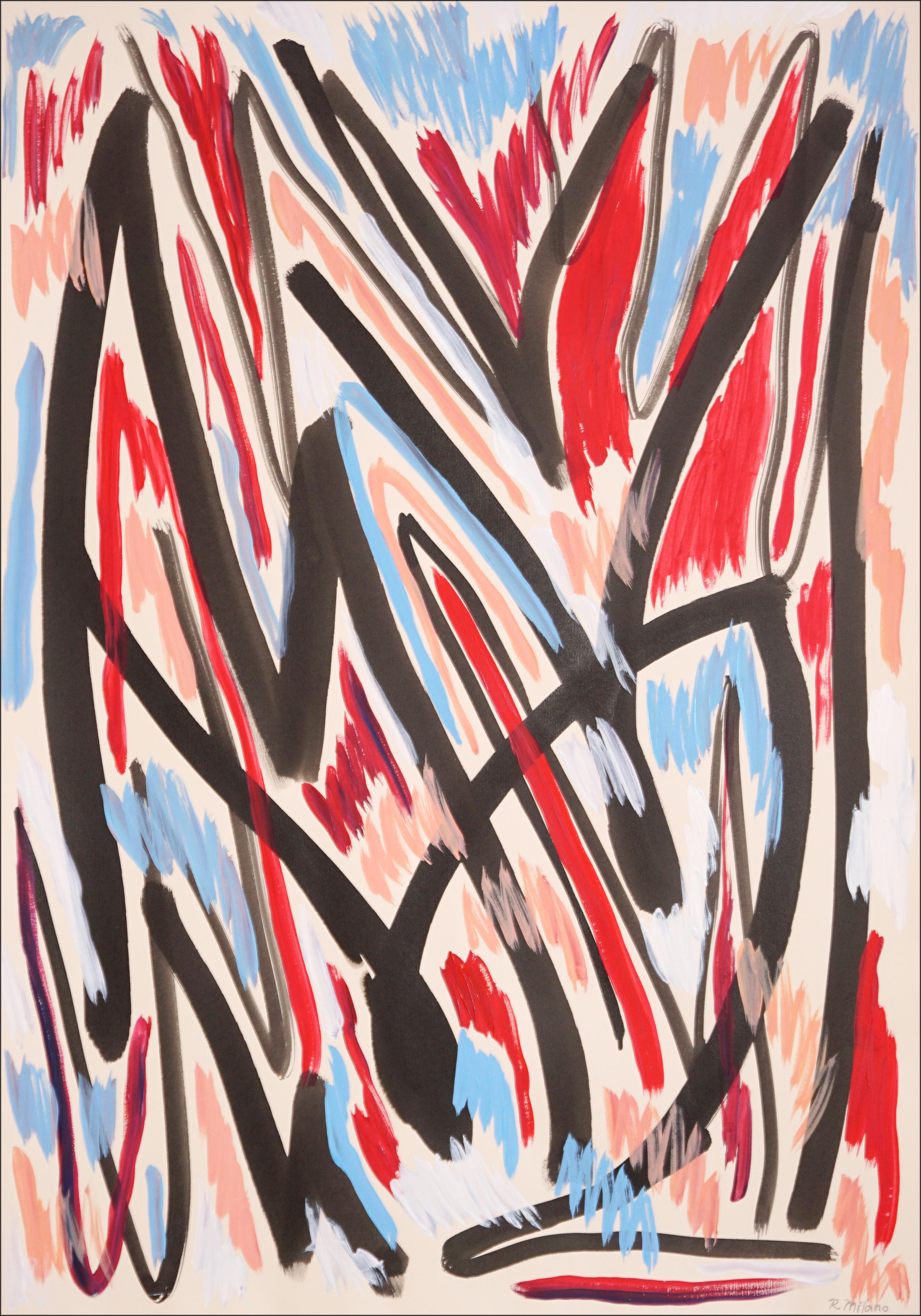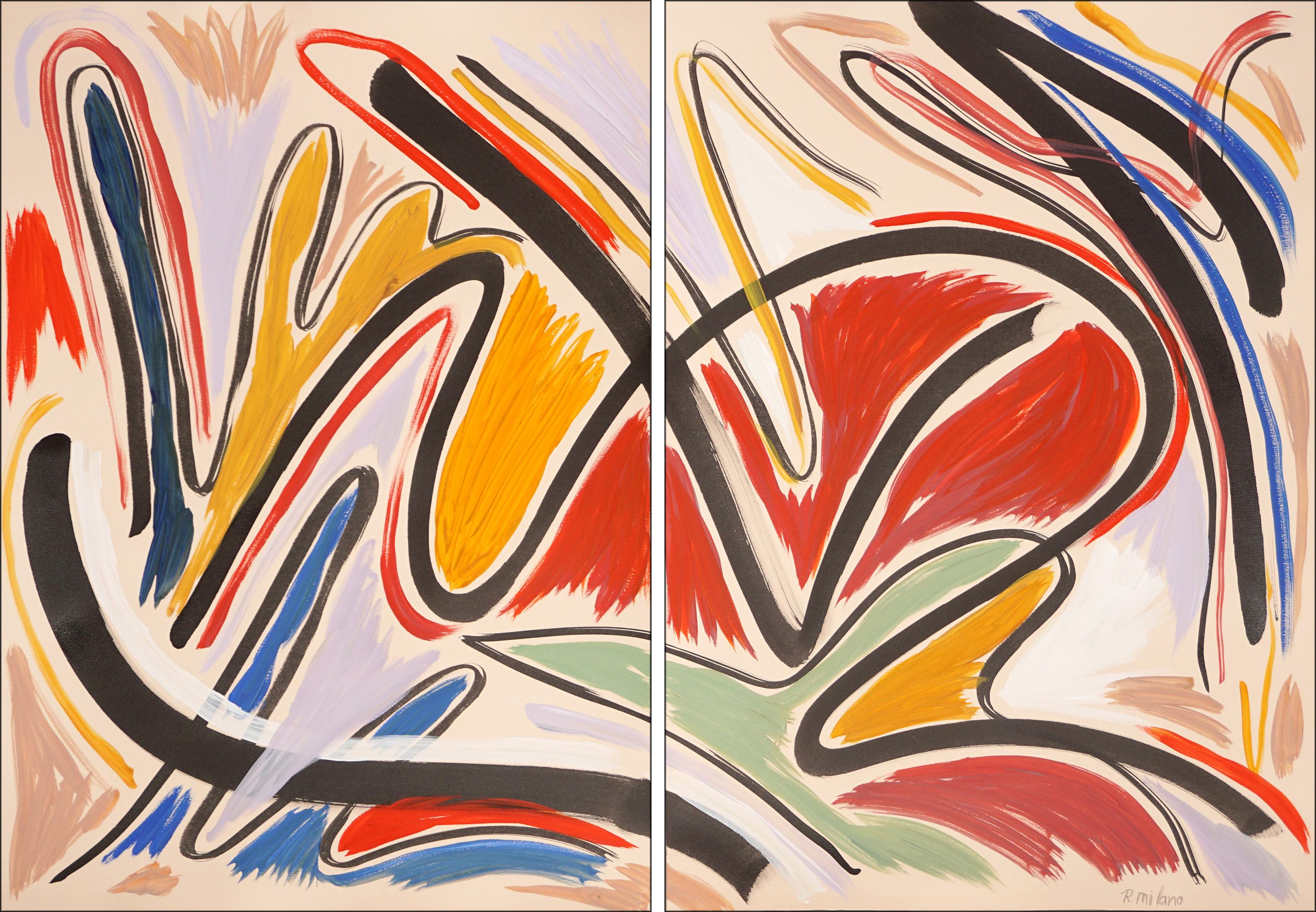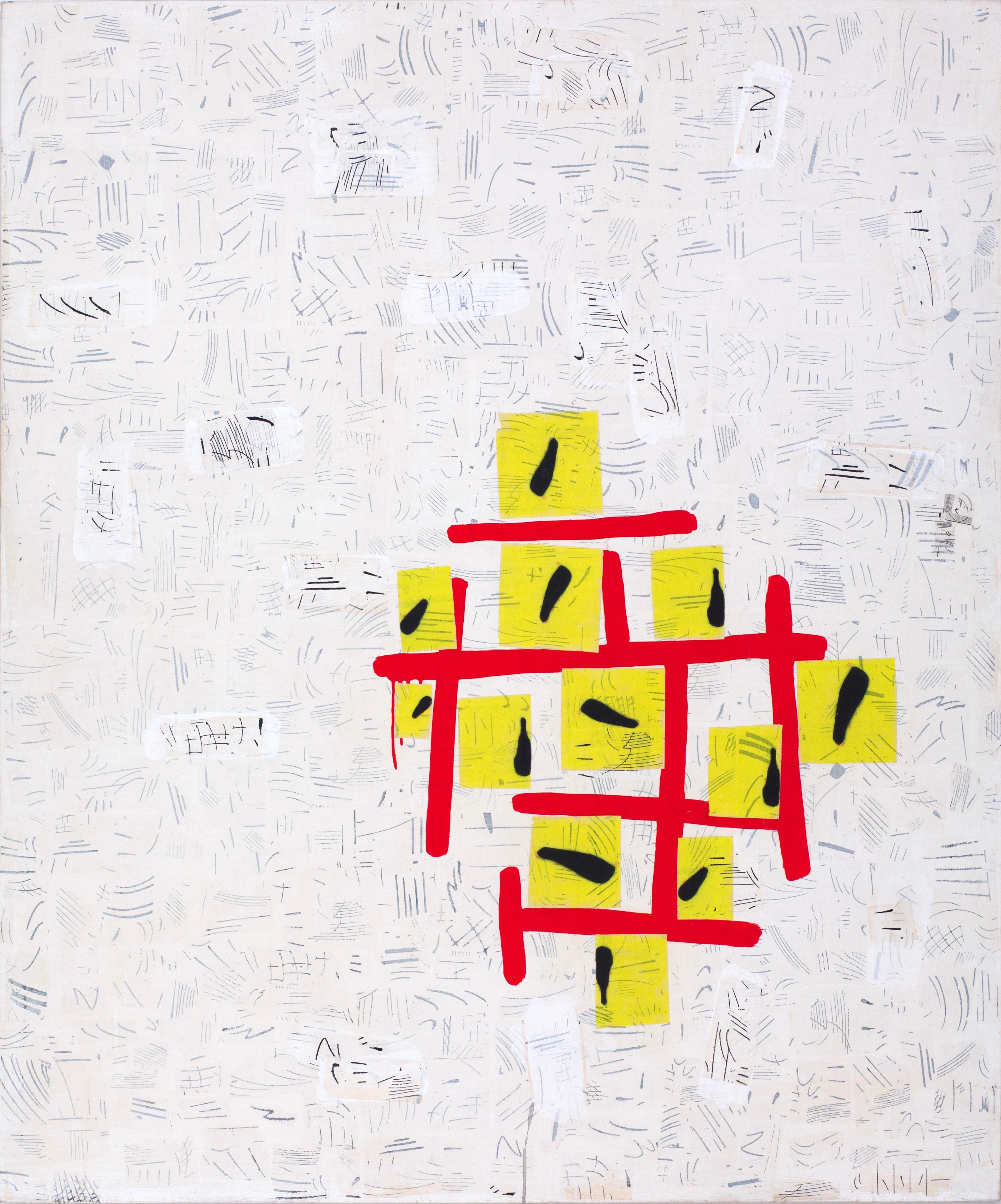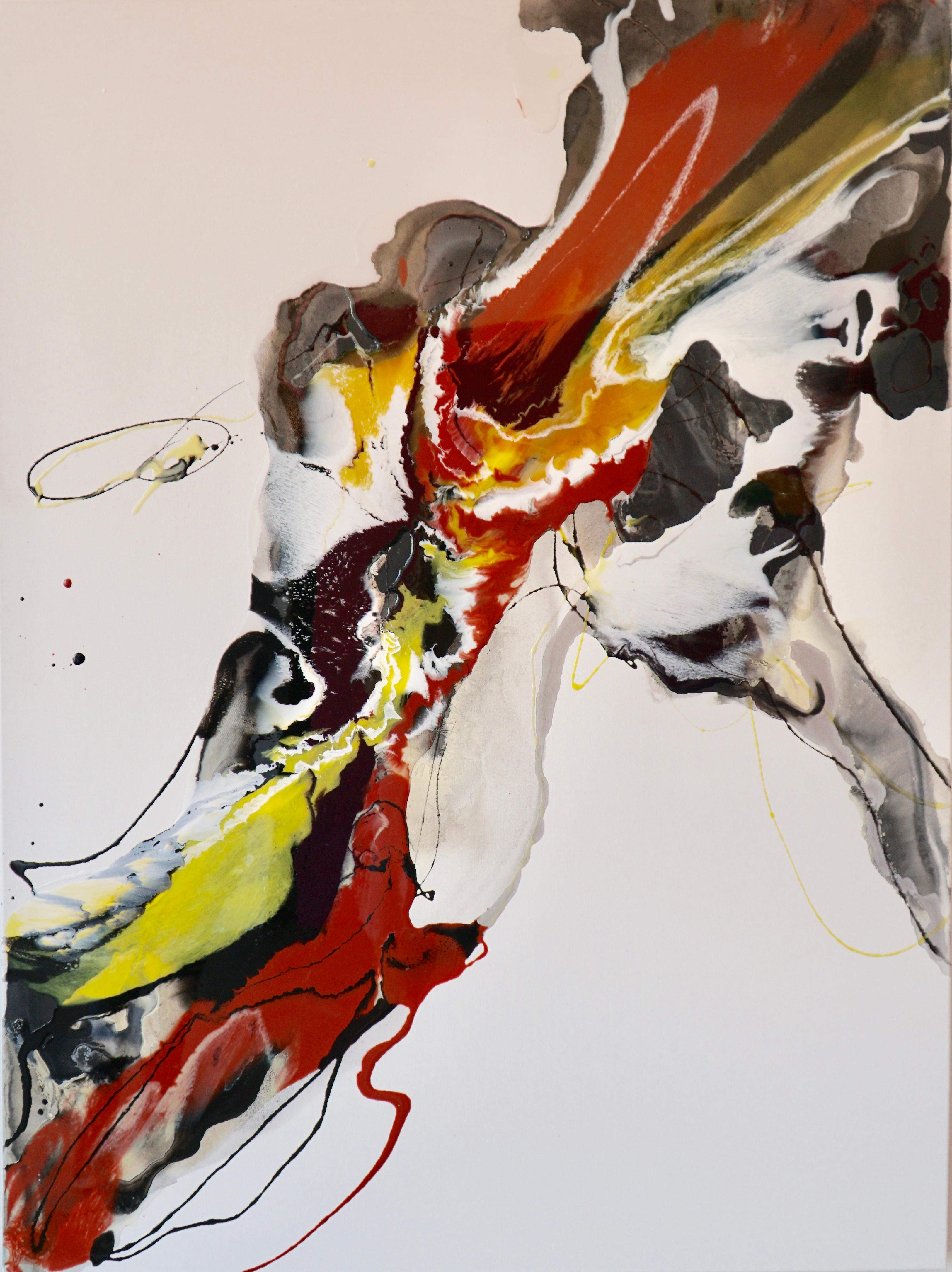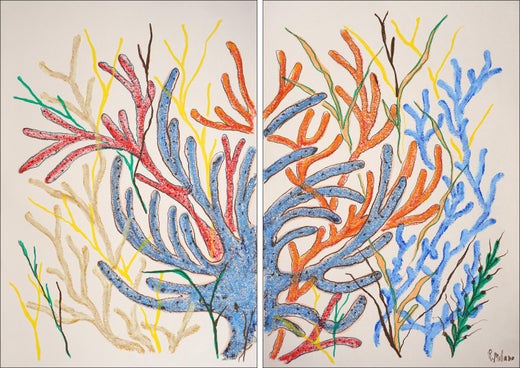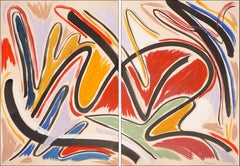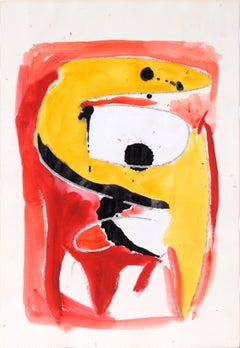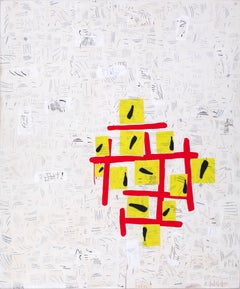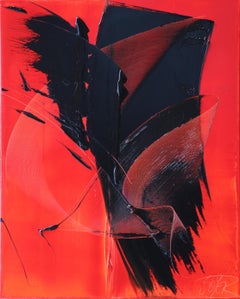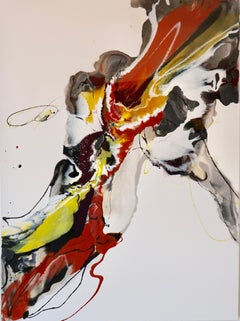Items Similar to The Bullfight, Abstract Expressionist Painting in Red and Yellow, Black Gestures
Want more images or videos?
Request additional images or videos from the seller
1 of 11
Romina MilanoThe Bullfight, Abstract Expressionist Painting in Red and Yellow, Black Gestures2023
2023
$474
$79040% Off
£360.01
£600.0240% Off
€415.94
€693.2340% Off
CA$664.33
CA$1,107.2140% Off
A$743.51
A$1,239.1840% Off
CHF 388.05
CHF 646.7640% Off
MX$9,066.97
MX$15,111.6140% Off
NOK 4,966.56
NOK 8,277.6140% Off
SEK 4,701.49
SEK 7,835.8240% Off
DKK 3,104.07
DKK 5,173.4640% Off
Shipping
Retrieving quote...The 1stDibs Promise:
Authenticity Guarantee,
Money-Back Guarantee,
24-Hour Cancellation
About the Item
"The Bullfight" is an abstract expressionist painting by Romina Milano where a dance of black gestures unfolds across colorful brushstrokes infused with raw emotion.
Romina Milano is an Italian artist renowned for her paintings that are primarily composed of strong gestures, vibrant colors, and daring experimentation with tones.
Details:
Title: The Bullfight
Medium: Acrylic and India Ink on Watecolor Paper
Size: 40x28 Inches, (100x70cm)
Year: 2023
* Frame is for illustrative purposes only. Artwork shipped carefully rolled and packaged in a tube.
* Certificate of Authenticity provided.
Milano's work is an intriguing amalgamation of abstract and figurative elements, where shapes and forms intertwine, and where bold brushstrokes combine with vibrant colors throughout the canvas. Milano's artistic process is deeply intuitive and organic, allowing her to fully immerse herself in the act of creation. She embraces spontaneity and embraces accidents, incorporating them into her work to create a sense of visual poetry and depth.
Following the deep-rooted traditions of Italian sensibility for design, her work aims to attract art enthusiasts and collectors who appreciate the seamless integration of artistic expression and timeless design principles, as she creates her works with the intention that they can be incorporated into any well-designed home or office.
- Creator:Romina Milano (1990, Italian)
- Creation Year:2023
- Dimensions:Height: 40 in (101.6 cm)Width: 28 in (71.12 cm)
- Medium:
- Movement & Style:
- Period:
- Condition:
- Gallery Location:Barcelona, ES
- Reference Number:Seller: A4191stDibs: LU1310212853082
Romina Milano is an Italian artist renowned for her paintings that are primarily composed of strong gestures, vibrant colors, and daring experimentation with tones. Her work is an intriguing amalgamation of abstract and figurative elements, where shapes and forms intertwine, and where bold brushstrokes combine with vibrant colors throughout the canvas. Milano's artistic process is deeply intuitive and organic, allowing her to fully immerse herself in the act of creation. She embraces spontaneity and embraces accidents, incorporating them into her work to create a sense of visual poetry and depth. Following the deep-rooted traditions of Italian sensibility for design, her work aims to attract art enthusiasts and collectors who appreciate the seamless integration of artistic expression and timeless design principles, as she creates her works with the intention that they can be incorporated into any well-designed home or office.
About the Seller
4.9
Platinum Seller
Premium sellers with a 4.7+ rating and 24-hour response times
Established in 2016
1stDibs seller since 2019
691 sales on 1stDibs
Typical response time: 1 hour
- ShippingRetrieving quote...Shipping from: Barcelona, Spain
- Return Policy
Authenticity Guarantee
In the unlikely event there’s an issue with an item’s authenticity, contact us within 1 year for a full refund. DetailsMoney-Back Guarantee
If your item is not as described, is damaged in transit, or does not arrive, contact us within 7 days for a full refund. Details24-Hour Cancellation
You have a 24-hour grace period in which to reconsider your purchase, with no questions asked.Vetted Professional Sellers
Our world-class sellers must adhere to strict standards for service and quality, maintaining the integrity of our listings.Price-Match Guarantee
If you find that a seller listed the same item for a lower price elsewhere, we’ll match it.Trusted Global Delivery
Our best-in-class carrier network provides specialized shipping options worldwide, including custom delivery.More From This Seller
View AllChanging Seasons, Abstract Expressionist Style in Red and Blue, Black Gestures
Located in Barcelona, ES
"Changing Seasons" is an abstract expressionist painting by Romina Milano where a dance of black gestures unfolds across colorful brushstrokes infused wi...
Category
2010s Neo-Expressionist Abstract Paintings
Materials
Acrylic, India Ink
Expressionist Diptych in Primary Tones, Abstract Music, Gestures in Black, Paper
Located in Barcelona, ES
"Tropical Music I" is an abstract expressionist painting by Romina Milano where a dance of black gestures unfolds across colorful brushstrokes infused with raw emotion.
Romina Mila...
Category
2010s Abstract Expressionist Abstract Paintings
Materials
Acrylic, Watercolor
Thinking About Cy, Expressionist Shapes, Turquoise, Orange, Black Urban Gestures
Located in Barcelona, ES
"Thinking About Cy" is an abstract expressionist painting by Romina Milano where a dance of black and orange gestures unfolds across turquoise vertical b...
Category
2010s Neo-Expressionist Abstract Paintings
Materials
Acrylic, Paper, India Ink
A Windy Day, Vigorous Gestures in Blue, Yellow and Black, Abstract Brushstrokes
Located in Barcelona, ES
"A Windy Day" is an abstract expressionist painting by Romina Milano where a dance of black gestures unfolds across colorful brushstrokes infused with ra...
Category
2010s Abstract Expressionist Abstract Paintings
Materials
Acrylic, Watercolor, India Ink
Emotions and Textures, Contemporary Abstraction, Modern Gestural, Spray, Paper
Located in Barcelona, ES
Emotions and Textures bursts with gestural freedom and expressive layering, capturing the raw vitality of contemporary abstraction. With bold brushstrokes, spray textures, and a vibr...
Category
2010s Neo-Expressionist Abstract Paintings
Materials
Paper, Oil Crayon, Acrylic
Wild Instant, Abstract Expressionist Gestures. Blooming Flowers in Vivid Tones
Located in Barcelona, ES
In this series, Perrine explores the profound relationship between light and color, both essential elements in her artistic expression. Without light, there would be no colors, and i...
Category
2010s Neo-Expressionist Abstract Paintings
Materials
Oil Crayon, Acrylic, Paper
You May Also Like
Abstract Expressionist Composition in Yellow, Red, and Black in Acrylic on Paper
Located in Soquel, CA
Lace Swirls - Abstract Expressionist Composition in Acrylic on Paper
A dynamic abstract painting by California-based artist, Ricardo de Silva (American/Brazil, 20th C). This piece i...
Category
1980s Abstract Expressionist Abstract Paintings
Materials
Paper, Acrylic, Wax Crayon
"Red/Yellow"Large Abstraction, Red, Yellow, Black, Cream, White, Pop Sensibility
By Margo Margolis
Located in Wellesley, MA
"Red/Yellow" Large Abstraction of Yellow, Red, Black, White and Cream. Flashe on Canvas, 72 x 60 Inches.
This painting has a very sophisticated sensibility in that it is purely...
Category
2010s Abstract Abstract Paintings
Materials
Mixed Media
Bold Modern Abstract Art: Striking Red Canvas with Black Gestural Strokes
By Jean Soyer
Located in Clermont-Ferrand, Auvergne-Rhône-Alpes
A striking abstract oil painting on canvas (32 x 26 inches) by Jean Soyer, featuring dramatic interplay between vibrant red and deep black. The composition showcases bold, dynamic br...
Category
21st Century and Contemporary Abstract Abstract Paintings
Materials
Canvas, Oil
Untitled - abstract painting in red orange yellow white black
By Lena Cher
Located in Fort Lee, NJ
Interior design paintings. Abstraction art, made in red, orange, yellow, black, white and grey. Can be positioned in horizontal or vertical mode.
Lena Chern...
Category
2010s Abstract Expressionist Abstract Paintings
Materials
Canvas, Epoxy Resin, Acrylic
Black Yellow & Red Abstract Expressionist Art by Contemporary British Artist
By Angela Wakefield
Located in Preston, GB
Black Yellow & Red Abstract Expressionist Painting by Leading Contemporary British Artist, Angela Wakefield
Art measures 36 x 36 inches
This original marks a return to Wakefield’s ...
Category
2010s Abstract Expressionist Abstract Paintings
Materials
Canvas, Paint, Cotton Canvas, Acrylic
$27,396 Sale Price
20% Off
Free Shipping
Abstract Expressionist Composition in Red, Black, and Blue Acrylic on Canvas
Located in Soquel, CA
Abstract Expressionist Composition in Red, Black, and Blue Acrylic on Canvas
Bold abstract composition with thick paint by an unknown artist, likely from the San Francisco Bay Area...
Category
21st Century and Contemporary Abstract Expressionist Abstract Paintings
Materials
Canvas, Acrylic
More Ways To Browse
Bullfight Paintings
Romina Milano
Tom Fairs
Candy Oil Painting
Dance Couple
Full Circle Modern
1960s Italian Oil
South Carolina Painting
Scribble Painting
Cobalt Blue Painting
Union Square
50 X 60 Painting
Davis Gray
Greenwich Village
Hawaii Abstract Art
Cat Abstract Painting
The New York Collection For Stockholm
Buffalo Oil Painting
